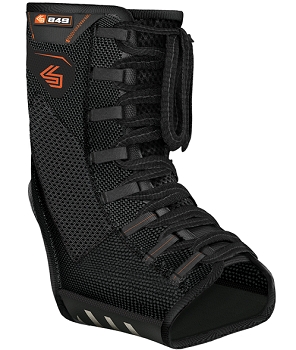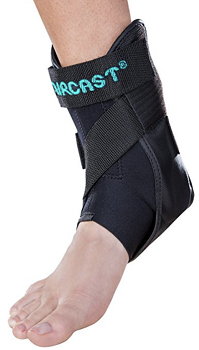We have suggested ankle braces to protect ankle joints from a sprain by restricting inversion and improving proprioception. The study showed that the semi-rigid ankle brace showed a positive effect compared to a soft brace and no brace. Semi-rigid ankle braces positively impact dynamic postural stability after landing on a single leg and may improve balance by increasing dynamic postural stability.
There are two types of semi-rigid braces-
- Lace-Up Ankle Brace
- Hinged Ankle Brace
Lace-Up Ankle Brace
Lace-up braces are one of the most familiar types of semi-rigid ankle braces. It uses for mild-to-moderate ankle sprains and for the prevention of repeat ankle sprains that occur with activity. Lace-up ankle braces are designed to limit the ankle from rolling side to side and then up and down ankle motion, theoretically providing full ankle support.

The benefits of lace-up braces comprise durability with a comfortable, lightweight feel; therefore, it provides more protection than the compression brace and fits in most shoes. Likewise, they are further universally fit for either the right or the left ankle.
Hinged Ankle Brace
Hinged ankle braces are other sorts of semi-rigid brace. These braces’ design prevents rolling the ankle from side to side without affecting the ankle up and down motion. They have padded sides for increased comfort and either one or two Velcro straps for quick adjustment and easy on-and-off application.

Hinged braces provide increased side-to-side support compared to the lace-up brace and designed to fit most shoes. They are constructed to fit the contour of the right or the left ankle. It’s important always to be proactive about your ankle injury prevention. If you are an active athlete, make sure your training program includes exercises that mobilize your ankles and strengthen your knees as well so they function properly and minimize your risk of injury. If you suffer an ankle or knee injury, always remember that using an ankle brace (semi-rigid ankle brace, a rigid ankle brace, or soft brace) only serves as a temporary solution. It should use only during the initial phase of your rehabilitation unless recommended by your attending physician.
Lace-Up Ankle Brace vs. Hinged Ankle Brace
Lace-up ankle brace and hinged ankle brace are two types of ankle braces commonly used to provide support, stability, and protection to an injured ankle or to prevent ankle injuries. Each brace type has its own set of advantages and is designed to cater to specific needs.
Lace-Up Ankle Brace:
- Support: Lace-up ankle braces offer moderate to high support, depending on the tightness of the laces. They are adjustable and provide a custom fit to the user.
- Flexibility: These braces are more flexible than hinged ankle braces, allowing for a greater range of motion. This makes them suitable for athletes and active individuals who require support but don’t want to compromise their mobility.
- Prevention: Lace-up braces are often used as a preventive measure for individuals with a history of ankle injuries, providing support during physical activities.
- Cost: Generally, lace-up ankle braces are less expensive than hinged ankle braces.
- Comfort: These braces are more comfortable for extended wear, as they are lightweight and less bulky.
Hinged Ankle Brace:
- Support: Hinged ankle braces provide high support and stability, making them ideal for those recovering from severe ankle injuries, such as sprains or fractures.
- Rigid structure: These braces have rigid side supports, which limit excessive side-to-side and rotational movement, helping to protect the ankle from further injury.
- Controlled range of motion: Hinged ankle braces allow for a controlled range of motion, which can be helpful during rehabilitation after an injury.
- Post-injury: These braces are usually recommended after an injury, as they provide maximum support and protection to the affected ankle.
- Cost: Hinged ankle braces are more expensive than lace-up braces due to their more complex design and construction.
